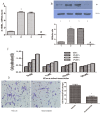4-1BBL has a Possible Role in Mediating Castration-Resistant Conversion of Prostate Cancer via Up-Regulation of Androgen Receptor
- PMID: 31258752
- PMCID: PMC6584334
- DOI: 10.7150/jca.29648
4-1BBL has a Possible Role in Mediating Castration-Resistant Conversion of Prostate Cancer via Up-Regulation of Androgen Receptor
Abstract
4-1BB ligand (4-1BBL) was a transmembrane glycoprotein belonging to the tumor necrosis factor family. It was expressed on activated T lymphocytes and function as a co-stimulatory molecule via cross-linking with 4-1BB (a.k.a, CD137). In addition to its role in immune regulation, 4-1BBL transmitted signals into the cells on which it was expressed (reverse signaling). 4-1BBL represented a promising target for enhancing antitumor immune responses. Recent studies indicated that 4-1BBL also expressed in non-immune cells and possessed different functions in various types of cells. Here, we reported that 4-1BBL didn't express in normal prostate tissues and benign prostatic hyperplasia tissues, but it expressed in prostate cancer (PCa) tissues at moderate level. Expression of 4-1BBL was up-regulated during the transition from PCa to castration resistant prostate cancer (CRPC). Increasing expression of 4-1BBL not only promoted expression of androgen receptor (AR), but also augmented proliferation and invasion ability of prostate cancer cells in androgen deprivation environment. These results were further verified by xenograft tumor experiments. Meanwhile, inhibiting AR signal pathway by chemical antagonist was able to significantly reduce 4-1BBL mediated proliferation and invasion of PCa cells. These novel findings indicated that 4-1BBL might mediate prostate cancer progression to castration-resistant prostate cancer via enhancing expression and function of AR.
Keywords: 4-1BBL; androgen receptor; castration resistant prostate cancer; prostate cancer.
Conflict of interest statement
Competing Interests: The authors have declared that no competing interest exists.
Figures





Similar articles
-
Androgen receptors in hormone-dependent and castration-resistant prostate cancer.Pharmacol Ther. 2013 Dec;140(3):223-38. doi: 10.1016/j.pharmthera.2013.07.003. Epub 2013 Jul 13. Pharmacol Ther. 2013. PMID: 23859952 Review.
-
Transcript Levels of Androgen Receptor Variant 7 and Ubiquitin-Conjugating Enzyme 2C in Hormone Sensitive Prostate Cancer and Castration-Resistant Prostate Cancer.Prostate. 2017 Jan;77(1):60-71. doi: 10.1002/pros.23248. Epub 2016 Aug 22. Prostate. 2017. PMID: 27550197
-
Estrogen induces androgen-repressed SOX4 expression to promote progression of prostate cancer cells.Prostate. 2015 Sep;75(13):1363-75. doi: 10.1002/pros.23017. Epub 2015 May 27. Prostate. 2015. PMID: 26015225
-
Lipocalin 2 over-expression facilitates progress of castration-resistant prostate cancer via improving androgen receptor transcriptional activity.Oncotarget. 2016 Sep 27;7(39):64309-64317. doi: 10.18632/oncotarget.11790. Oncotarget. 2016. PMID: 27602760 Free PMC article.
-
Androgen receptor: what we know and what we expect in castration-resistant prostate cancer.Int Urol Nephrol. 2018 Oct;50(10):1753-1764. doi: 10.1007/s11255-018-1964-0. Epub 2018 Aug 20. Int Urol Nephrol. 2018. PMID: 30128923 Review.
Cited by
-
Emerging proteins involved in castration‑resistant prostate cancer via the AR‑dependent and AR‑independent pathways (Review).Int J Oncol. 2023 Nov;63(5):127. doi: 10.3892/ijo.2023.5575. Epub 2023 Sep 21. Int J Oncol. 2023. PMID: 37732538 Free PMC article. Review.
-
The role of IL‑17, IFN‑γ, 4‑1BBL and tumour‑infiltrating lymphocytes in the occurrence, development and prognosis of pancreatic cancer.Oncol Lett. 2024 Dec 5;29(2):88. doi: 10.3892/ol.2024.14834. eCollection 2025 Feb. Oncol Lett. 2024. PMID: 39677412 Free PMC article.
-
Prostate cancer immunotherapy: a review of recent advancements with novel treatment methods and efficacy.Am J Clin Exp Urol. 2022 Aug 15;10(4):210-233. eCollection 2022. Am J Clin Exp Urol. 2022. PMID: 36051616 Free PMC article. Review.
-
TNFSF9 promotes metastasis of pancreatic cancer through Wnt/Snail signaling and M2 polarization of macrophages.Aging (Albany NY). 2021 Sep 13;13(17):21571-21586. doi: 10.18632/aging.203497. Epub 2021 Sep 13. Aging (Albany NY). 2021. PMID: 34517345 Free PMC article.
-
Immunotherapy in Prostate Cancer: State of Art and New Therapeutic Perspectives.Curr Oncol. 2023 Jun 13;30(6):5769-5794. doi: 10.3390/curroncol30060432. Curr Oncol. 2023. PMID: 37366915 Free PMC article. Review.
References
-
- Jemal A, Bray F, Center MM. et al. Global cancer statistics. CA Cancer J Clin. 2011;61:69–90. - PubMed
-
- Larsson R, Mongan NP, Johansson M. et al. Clinical trial update and novel therapeutic approaches for metastatic prostate cancer. Curr Med Chem. 2011;18:4440–4453. - PubMed
-
- Locksley RM, Killeen N, Lenardo MJ. The TNF and TNF receptor superfamilies: integrating mammalian biology. Cell. 2001;104:487–501. - PubMed
-
- Laderach D, Movassagh M, Johnson A. et al. 4-1BB co-stimulation enhances human CD8(+) T cell priming by augmenting the proliferation and survival of effector CD8(+) T cells. Int Immunol. 2002;14:1155–1167. - PubMed
LinkOut - more resources
Full Text Sources
Research Materials

